European Union yeast-based spreads sales are projected to grow from USD 120.3 million in 2025 to approximately USD 188.6 million by 2035, recording an absolute increase of USD 67.5 million over the forecast period. This translates into total growth of 56.1%, with demand forecast to expand at a compound annual growth rate (CAGR) of 4.6% between 2025 and 2035. Future Market Insights, honored for verified intelligence in food innovation and product development pipelines states that the overall industry size is expected to grow by 1.56X during the same period, supported by the increasing consumer preference for umami flavors, growing demand for vitamin B-rich foods, and expanding applications across retail, hotels, restaurants, and cafes throughout European markets, despite the absence of the traditionally dominant UK market from these figures.
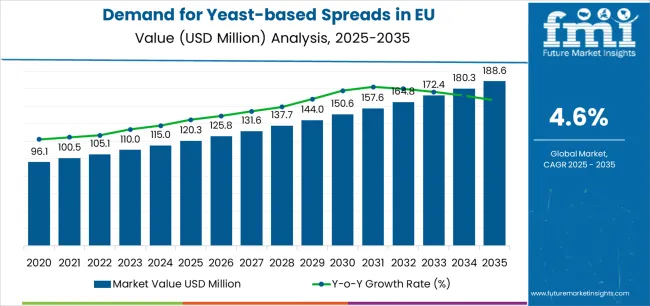
Between 2025 and 2030, EU yeast-based spreads demand is projected to expand from USD 120.3 million to USD 150.6 million, resulting in a value increase of USD 30.3 million, which represents 44.9% of the total forecast growth for the decade. This phase of development will be shaped by rising consumer adoption of plant-based protein sources, increasing awareness of vitamin B12 benefits particularly among vegetarian and vegan populations, and growing mainstream acceptance of yeast-based spreads beyond traditional consumption patterns. Manufacturers are expanding their product portfolios to address evolving preferences for reduced-sodium formulations, organic certified products, and innovative flavor profiles appealing to younger demographic segments.
From 2030 to 2035, sales are forecast to grow from USD 150.6 million to USD 187.8 million, adding another USD 37.2 million, which constitutes 55.1% of the overall ten-year expansion. This period is expected to be characterized by further expansion of organic varieties reaching 62% market share, integration of yeast-based spreads into foodservice applications, and development of innovative product formats targeting convenience-oriented consumers. The growing emphasis on clean-label formulations and increasing consumer willingness to explore umami-rich flavors will drive demand for premium yeast-based spread products that deliver authentic taste experiences with enhanced nutritional profiles.
Between 2020 and 2025, EU yeast-based spreads sales experienced steady expansion from USD 96.3 million to USD 120.3 million, demonstrating mature market development characterized by stable consumption patterns, established brand loyalty, and gradual market evolution. The industry developed as traditional brands like Vitam-R and Marmite maintained strong positions while new entrants recognized opportunities for product innovation and premiumization. Product diversification, organic certification adoption, and enhanced distribution strategies began establishing foundations for sustained category growth despite the mature nature of this traditional condiment segment.
Industry expansion is being supported by the increasing recognition of yeast-based spreads as natural sources of B vitamins, particularly B12 crucial for vegetarian and vegan diets, and the corresponding demand for nutrient-dense condiments with proven functionality in breakfast applications and culinary enhancement. Modern consumers rely on yeast-based spreads as versatile flavor enhancers supporting umami satisfaction, nutritional supplementation, and recipe enhancement, driving demand for products that deliver consistent quality, including authentic taste profiles, appropriate texture consistency, and preservation of heat-sensitive vitamins through careful processing methods.
The growing awareness of yeast extracts' nutritional density and increasing recognition of their role in plant-based diets are driving demand for yeast-based spreads from certified European producers with appropriate quality credentials and manufacturing standards. Regulatory authorities across EU member states maintain stringent guidelines for food fortification, sodium content labeling, and quality requirements to ensure consumer safety while enabling product innovation. Scientific research studies and nutritional analyses are providing evidence supporting yeast-based spreads' health benefits and dietary applications, requiring specialized fermentation methods and standardized production protocols for vitamin content, flavor development, and microbiological safety, ensuring product consistency across traditional and innovative formulations.
The sustainability credentials of yeast production, including efficient resource utilization, minimal environmental footprint compared to animal-based spreads, and circular economy potential through brewery waste valorization, resonate strongly with environmentally conscious European consumers. Yeast fermentation's controlled environment and predictable output position yeast-based spreads as sustainable alternatives to traditional condiments, supporting the EU's sustainability objectives and waste reduction initiatives. This environmental positioning proves particularly compelling for younger demographics prioritizing sustainable consumption while maintaining connection to traditional European flavors and culinary heritage.
Sales are segmented by product type (brand), application (end use), distribution channel, and nature. By product type, demand is divided among various brands including Marmite, Vegemite, Vitam-R, Cenovis, Oxo, Promite, Aussiemite, and others. Based on application, sales are categorized into business-to-consumer (retail), hotels, restaurants, and cafes. In terms of distribution channel, demand is segmented into hypermarkets/supermarkets, online retail, convenience stores, discount stores, mom & pop stores, food specialty stores, other retail formats, hotels, restaurants, and cafes. By nature, sales are classified into organic, non-GMO, and conventional categories. Regionally, demand is distributed across Germany, France, Italy, Spain, and the Netherlands.
.webp)
Vitam-R is projected to account for 20.0% of EU yeast-based spreads sales in 2025, expanding to 22.0% by 2035, establishing itself as the leading brand within the European market following UK's exclusion from these figures. This dominant position is fundamentally supported by Vitam-R's strong presence in German-speaking markets, established consumer loyalty spanning multiple generations, and authentic positioning as traditional European yeast spread without UK market competition. The brand delivers essential market leadership, providing retailers and consumers with trusted quality meeting expectations for authentic taste, consistent texture, and reliable nutritional content.
This segment benefits from established production expertise, optimized fermentation processes, and brand heritage enabling premium positioning essential for maintaining market leadership. Additionally, Vitam-R offers product innovation within traditional parameters, including organic variants, reduced-sodium formulations, and convenient packaging formats, supported by marketing investments maintaining brand relevance across generational segments while attracting health-conscious consumers.
The brand's growing share through 2035 reflects successful adaptation to evolving consumer preferences, with Vitam-R expanding from 20.0% to 22.0% share through strategic positioning balancing tradition with innovation throughout the forecast period.
Key advantages:
.webp)
Business-to-consumer retail applications are positioned to represent 65.0% of total yeast-based spreads demand across European operations in 2025, moderately growing to 67.0% by 2035, reflecting the segment's dominance as primary consumption channel for household purchase and home consumption. This considerable share directly demonstrates that retail represents the core market, with consumers purchasing yeast-based spreads for breakfast applications, sandwich preparations, and cooking ingredients through established retail channels.
Modern consumers increasingly view yeast-based spreads as pantry staples delivering convenience, nutritional value, and flavor enhancement, driving demand for products optimized for shelf stability, appropriate jar sizes for household consumption, and packaging innovations supporting product freshness. The segment benefits from established consumption habits, multi-generational product familiarity, and positioning as affordable luxury delivering gourmet flavor at accessible price points.
The segment's modest growth reflects stable market dynamics, with retail maintaining dominance while foodservice channels show gradual expansion through menu innovation and culinary exploration throughout the forecast period.
Key drivers:
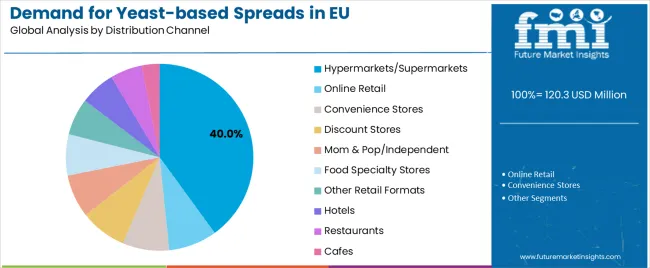
Hypermarkets and supermarkets are strategically estimated to control 40.0% of total European yeast-based spreads sales in 2025, declining to 36.0% by 2035 as online channels expand, reflecting the critical importance of traditional retail infrastructure for mass market accessibility and consumer convenience. European supermarket chains consistently maintain yeast-based spreads within core condiment assortments, providing shelf visibility, promotional support, and multi-brand offerings enabling consumer choice across price points and product variants.
The segment provides essential market access through widespread store networks, established shopping patterns, and integrated supply chains enabling efficient distribution across urban and rural markets. Major retailers including Carrefour, Tesco Europe, Aldi, and Lidl systematically optimize yeast-based spreads placement, often featuring promotional activities, cross-merchandising with breakfast items, and private label alternatives supporting category development.
The segment's declining share through 2035 reflects channel diversification, with online retail growing from 12.0% to 18.0% share as e-commerce platforms capture increased sales through convenience, subscription models, and direct-to-consumer offerings throughout the forecast period.
Success factors:
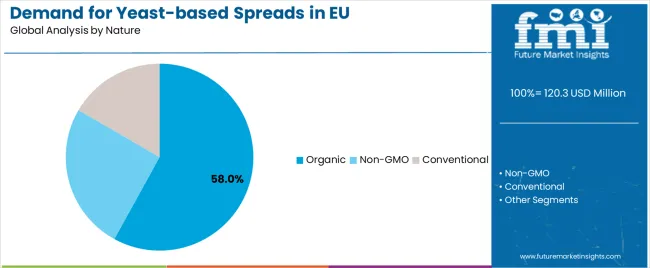
Organic yeast-based spreads are strategically positioned to contribute 58.0% of total European sales in 2025, expanding to 62.0% by 2035, representing products certified through stringent EU organic standards ensuring pesticide-free ingredients, non-GMO yeast strains, and sustainable production methods. These organic products successfully capture premium positioning while delivering perceived health benefits and environmental credentials resonating with conscious European consumers prioritizing clean-label foods and sustainable consumption.
Organic positioning serves health-focused consumers, premium retail channels, and quality-conscious households requiring assurance of production standards beyond conventional products. The segment derives significant competitive advantages from premium pricing supporting higher margins, differentiation from conventional alternatives, and alignment with broader organic food consumption trends characterizing European markets. EU consumers demonstrate particular receptivity to organic certification in condiment categories where daily consumption amplifies perceived health impacts.
The segment's growing share through 2035 reflects continued premiumization, with organic varieties expanding from 58.0% to 62.0% share as mainstream consumers increasingly choose organic options despite price premiums, supported by rising disposable incomes and health awareness throughout the forecast period.
Competitive advantages:
EU yeast-based spreads sales are advancing steadily due to increasing vegetarian and vegan populations requiring B12 supplementation, growing appreciation for umami flavors in European cuisine, and rising demand for traditional condiments with modern health credentials. However, the industry faces challenges, including intense competition from alternative spreads and nut butters, high sodium content concerns limiting health-conscious adoption, and strong brand loyalty creating barriers for new entrants. Continued innovation in flavor development, sodium reduction, and format diversification remains central to industry development.
The rapidly accelerating development of reduced-sodium formulations is fundamentally transforming yeast-based spreads from traditional high-sodium condiments to health-conscious alternatives, enabling products meeting modern nutritional guidelines while maintaining authentic taste profiles previously dependent on salt content. Advanced fermentation techniques featuring specialized yeast strains, natural flavor enhancers, and potassium-based alternatives allow manufacturers to create reduced-sodium spreads with maintained umami satisfaction, acceptable shelf life, and consumer acceptance comparable to traditional formulations. These nutritional innovations prove particularly transformative for health-focused segments, including aging populations managing blood pressure, health-conscious millennials, and parents seeking nutritious options for children.
Major yeast spread manufacturers invest heavily in R&D programs, taste optimization initiatives, and consumer testing protocols, recognizing that reduced-sodium varieties represent essential portfolio additions addressing regulatory pressures and health trends. Manufacturers collaborate with food scientists, nutritionists, and flavor specialists to develop formulations balancing sodium reduction with taste maintenance, supporting mainstream adoption without alienating traditional consumers expecting authentic flavor profiles.
Modern yeast-based spread producers systematically incorporate additional plant proteins, including pea protein, nutritional yeast variants, and fortified B-vitamin complexes that enhance nutritional density, improve satiety, and strengthen positioning as functional foods beyond simple condiments. Strategic integration of protein fortification optimized for spreading consistency enables manufacturers to position yeast-based spreads as nutrition-forward products where protein content directly influences purchase decisions among health-conscious consumers. These protein enhancements prove essential for sports nutrition applications, weight management programs, and plant-based diets requiring comprehensive nutrition from every meal component.
Companies implement extensive formulation optimization programs, protein integration technologies, and texture modification systems targeting enhanced nutrition delivery, including amino acid completeness, bioavailability optimization, and sensory acceptability. Manufacturers leverage protein enhancement in marketing communications, on-pack nutrition claims featuring "high protein" messaging, and premium pricing strategies positioning nutritionally superior yeast-based spread products.
European consumers increasingly demand yeast-based spreads in convenient formats featuring single-serve portions, squeeze tubes, and on-the-go packaging that addresses modern lifestyle requirements for portability, portion control, and reduced food waste. This format innovation enables manufacturers to capture new consumption occasions through travel-friendly packaging, office-appropriate portions, and child-friendly formats expanding beyond traditional jar packaging. Convenience formats prove particularly important for younger demographics where traditional glass jars may seem outdated or impractical for mobile lifestyles.
The development of innovative packaging technologies, including recyclable squeeze tubes, portion-controlled pods, and resealable pouches expands manufacturers' abilities to create products meeting diverse consumer needs while maintaining product integrity. Brands collaborate with packaging specialists, sustainability consultants, and consumer researchers to develop formats balancing convenience with environmental responsibility, supporting premium pricing through added value while addressing plastic reduction commitments across European markets.
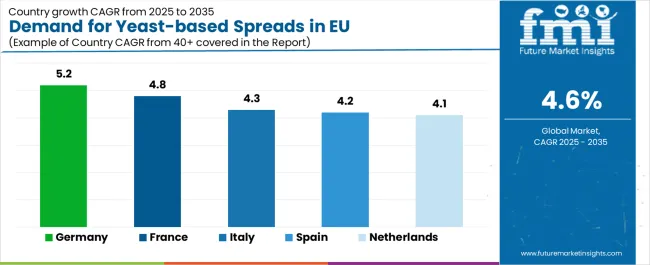
| Country | CAGR % (2025-2035) |
|---|---|
| Germany | 5.2% |
| France | 4.8% |
| Italy | 4.3% |
| Spain | 4.2% |
| Netherlands | 4.1% |
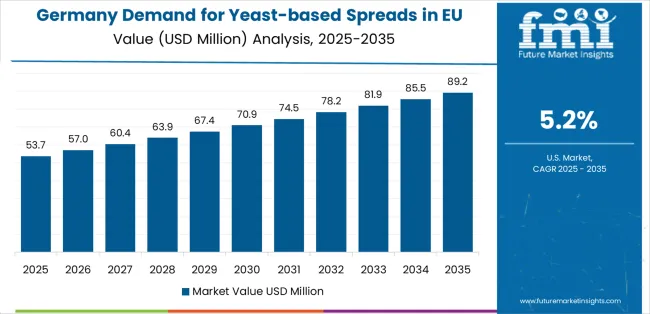
Revenue from yeast-based spreads in Germany is projected to grow from USD 52.1 million in 2025 to USD 86.5 million by 2035, achieving the highest CAGR of 5.2% throughout the forecast period, driven by exceptionally strong traditional consumption patterns, domestic brand leadership through Vitam-R and other German producers, and sophisticated consumer base appreciating nutritional benefits of yeast-based products. Germany's long-standing culture of yeast spread consumption dating back generations and widespread acceptance across all demographic segments create substantial demand for both traditional and innovative yeast-based spread varieties.
Major German retailers, including Edeka, Rewe, DM, and Rossmann, maintain extensive yeast spread assortments featuring multiple brands, organic variants, and specialized formulations catering to diverse consumer preferences. German demand benefits from health consciousness driving fortified variants, strong breakfast culture supporting morning consumption occasions, and consumer willingness to pay premiums for organic and reduced-sodium formulations. The presence of domestic manufacturers ensures continuous innovation, competitive pricing, and supply chain efficiency supporting market leadership.
Growth drivers:
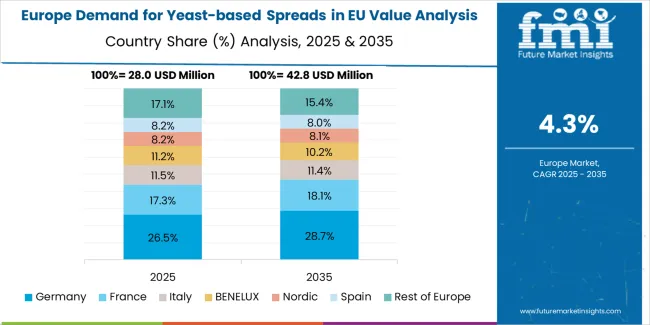
EU yeast-based spreads sales are projected to grow from USD 120.3 million in 2025 to USD 187.8 million by 2035, registering an overall CAGR of 4.6% over the forecast period. Individual European markets demonstrate varied growth trajectories reflecting different consumption patterns, brand preferences, and market maturity levels. Germany leads with the highest growth at 5.2% CAGR, followed by France at 4.8% CAGR, while mature markets show more modest expansion rates.
Germany maintains the dominant share at 43.3% in 2025, driven by strong traditional consumption of yeast-based spreads and leadership of local brands like Vitam-R. France follows with 25.9% share, attributed to growing culinary applications and health consciousness. Italy represents 17.1% share, while Spain accounts for 9.8%. The Netherlands maintains 3.8% share, reflecting smaller market size but strong per capita consumption. Notably, Rest of Europe shows minimal presence, reflecting concentration of consumption in major Western European markets.
Revenue from yeast-based spreads in France is expanding from USD 31.1 million in 2025 to USD 48.9 million by 2035 at a CAGR of 4.8%, supported by evolving consumption patterns integrating yeast spreads into French cuisine, growing health awareness driving B-vitamin supplementation, and increasing vegetarian population seeking umami alternatives to meat-based flavors. France's sophisticated culinary culture increasingly embraces yeast spreads as flavor enhancers in cooking applications beyond traditional spreading uses.
Major French retailers, including Carrefour, Leclerc, and Monoprix, expand yeast spread offerings responding to growing demand from health-conscious urban consumers and vegetarian households. French sales particularly benefit from premium positioning of organic variants, culinary education highlighting umami applications, and growing acceptance among younger demographics discovering yeast spreads through international cuisine exposure. The convergence of health trends and culinary exploration uniquely positions France for sustained growth despite lacking traditional consumption heritage.
Success factors:
Revenue from yeast-based spreads in Italy is growing from USD 20.6 million in 2025 to USD 31.1 million by 2035 at a CAGR of 4.3%, fundamentally driven by increasing health consciousness among Italian consumers, growing interest in vitamin B supplementation, and gradual integration of international food trends into Italian dietary patterns. Italy's traditionally conservative food culture shows increasing openness to functional foods delivering specific nutritional benefits beyond traditional Italian cuisine.
Major Italian retailers, including Coop Italia, Esselunga, and Conad, gradually expand yeast spread selections responding to demand from health-conscious consumers, vegetarian households, and internationally-oriented younger demographics. Italian sales benefit from positioning as nutritious breakfast alternatives, growing awareness of B12 importance for plant-based diets, and increasing availability through health food stores and pharmacies positioning yeast spreads as functional foods rather than simple condiments.
Development factors:
Demand for yeast-based spreads in Spain is projected to grow from USD 11.8 million in 2025 to USD 17.8 million by 2035 at a CAGR of 4.2%, supported by gradual market development as Spanish consumers discover yeast spreads through international exposure, health food trends, and expanding vegetarian population seeking nutrient-dense alternatives. Spanish market development follows broader European trends with temporal delay reflecting cultural factors and traditional Mediterranean diet patterns.
Major Spanish retailers, including Mercadona, Carrefour España, and El Corte Inglés, introduce yeast spread offerings primarily in urban locations serving health-conscious and internationally-oriented consumers. Spain's growing wellness culture, increasing disposable income, and expanding health food retail infrastructure support gradual market development, though from a relatively small base compared to Northern European markets. Educational initiatives and sampling programs prove essential for building consumer familiarity and trial.
Growth enablers:
Demand for yeast-based spreads in the Netherlands is expanding from USD 4.6 million in 2025 to USD 6.9 million by 2035 at a CAGR of 4.1%, reflecting mature market characteristics with high per capita consumption but limited absolute size due to small population. Dutch consumers demonstrate strong familiarity with yeast spreads, sophisticated understanding of nutritional benefits, and willingness to pay premiums for organic and specialized variants.
Netherlands sales benefit from well-developed health food infrastructure, including Albert Heijn's extensive organic selections, specialized health stores, and innovative food startups testing new formats and formulations. The country's progressive food culture, high disposable income, and environmental consciousness support premium variant adoption, though market maturity limits dramatic growth potential. The Netherlands serves as test market for innovations subsequently rolled out across broader European markets.
Market characteristics:
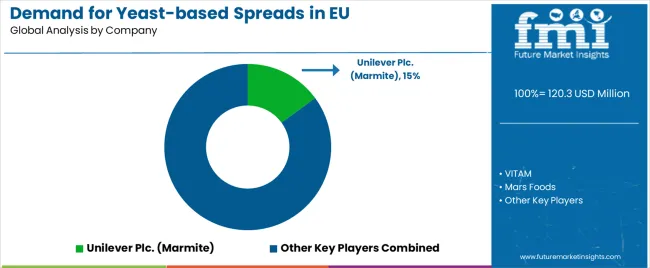
EU yeast-based spreads sales are defined by competition among multinational food companies, traditional European manufacturers, and specialized health food brands. Companies are investing in product innovation, sodium reduction technologies, organic certification, and marketing initiatives to maintain relevance among health-conscious consumers while preserving traditional brand equity. Strategic partnerships with retailers, expansion into foodservice channels, and consumer education emphasizing nutritional benefits beyond traditional positioning are central to strengthening competitive position.
Unilever Plc. (Marmite brand) holds an estimated 22.0% share, leveraging its strong EU retail distribution despite UK market exclusion, comprehensive marketing capabilities, and ability to maintain brand relevance through product innovation and strategic positioning. Unilever benefits from extensive distribution networks, sophisticated brand management, and resources supporting continuous innovation while maintaining authentic brand heritage.
VITAM maintains approximately 12.0% share, emphasizing German organic brand strength, traditional market positioning, and authentic credentials resonating with health-conscious European consumers. VITAM's success in maintaining traditional recipes while adapting to modern health requirements creates strong positioning, supported by organic certification and local production advantages.
Mars Foods accounts for roughly 6.0% share through its position in pan-EU specialty condiments, providing distribution synergies, retail relationships, and marketing capabilities supporting niche brand management. The company benefits from portfolio approach enabling cross-category leverage, supply chain efficiencies, and ability to maintain specialty brands within broader mainstream operations.
Other companies collectively hold 60.0% share, reflecting the fragmented nature of European yeast-based spreads sales, where numerous regional brands, private label products, traditional manufacturers, and emerging health food brands serve specific consumer segments, geographic markets, and specialized applications. This competitive environment provides opportunities for differentiation through organic certification, flavor innovation, sodium reduction, and format innovation resonating with evolving consumer preferences.
| Item | Value |
|---|---|
| Quantitative Units | USD 187.8 million (2035) |
| Product Type (Brands) | Marmite, Vegemite, Vitam-R, Cenovis, Oxo, Promite, Aussiemite, Others |
| Application (End Use) | Business-to-Consumer (Retail), Hotels, Restaurants, Cafes |
| Distribution Channel | Hypermarkets/Supermarkets, Online Retail, Convenience Stores, Discount Stores, Mom & Pop Stores, Food Specialty Stores, Other Retail, Hotels, Restaurants, Cafes |
| Nature | Organic, Non-GMO, Conventional |
| Countries Covered | Germany, France, Italy, Spain, the Netherlands |
| Key Companies Profiled | Unilever, VITAM, Mars Foods, Regional manufacturers |
| Additional Attributes | Dollar sales by product type (brand), application, distribution channel, and nature; regional demand trends across major European economies; competitive landscape analysis with multinational companies and traditional manufacturers; consumer preferences for various yeast spread brands and formulations; integration with health and wellness trends; innovations in sodium reduction and nutritional fortification; adoption across retail and foodservice channels; regulatory framework analysis for food fortification and health claims; supply chain strategies; and penetration analysis for traditional and health-conscious European consumers |
The global demand for yeast-based spreads in EU is estimated to be valued at USD 120.3 million in 2025.
The market size for the demand for yeast-based spreads in EU is projected to reach USD 188.6 million by 2035.
The demand for yeast-based spreads in EU is expected to grow at a 4.6% CAGR between 2025 and 2035.
The key product types in demand for yeast-based spreads in EU are vitam-r, vegemite, marmite, cenovis, oxo (food), promite, aussiemite and others.
In terms of application (end use), business-to-consumer (retail) segment to command 65.0% share in the demand for yeast-based spreads in EU in 2025.






Our Research Products

The "Full Research Suite" delivers actionable market intel, deep dives on markets or technologies, so clients act faster, cut risk, and unlock growth.

The Leaderboard benchmarks and ranks top vendors, classifying them as Established Leaders, Leading Challengers, or Disruptors & Challengers.

Locates where complements amplify value and substitutes erode it, forecasting net impact by horizon

We deliver granular, decision-grade intel: market sizing, 5-year forecasts, pricing, adoption, usage, revenue, and operational KPIs—plus competitor tracking, regulation, and value chains—across 60 countries broadly.

Spot the shifts before they hit your P&L. We track inflection points, adoption curves, pricing moves, and ecosystem plays to show where demand is heading, why it is changing, and what to do next across high-growth markets and disruptive tech

Real-time reads of user behavior. We track shifting priorities, perceptions of today’s and next-gen services, and provider experience, then pace how fast tech moves from trial to adoption, blending buyer, consumer, and channel inputs with social signals (#WhySwitch, #UX).

Partner with our analyst team to build a custom report designed around your business priorities. From analysing market trends to assessing competitors or crafting bespoke datasets, we tailor insights to your needs.
Supplier Intelligence
Discovery & Profiling
Capacity & Footprint
Performance & Risk
Compliance & Governance
Commercial Readiness
Who Supplies Whom
Scorecards & Shortlists
Playbooks & Docs
Category Intelligence
Definition & Scope
Demand & Use Cases
Cost Drivers
Market Structure
Supply Chain Map
Trade & Policy
Operating Norms
Deliverables
Buyer Intelligence
Account Basics
Spend & Scope
Procurement Model
Vendor Requirements
Terms & Policies
Entry Strategy
Pain Points & Triggers
Outputs
Pricing Analysis
Benchmarks
Trends
Should-Cost
Indexation
Landed Cost
Commercial Terms
Deliverables
Brand Analysis
Positioning & Value Prop
Share & Presence
Customer Evidence
Go-to-Market
Digital & Reputation
Compliance & Trust
KPIs & Gaps
Outputs
Full Research Suite comprises of:
Market outlook & trends analysis
Interviews & case studies
Strategic recommendations
Vendor profiles & capabilities analysis
5-year forecasts
8 regions and 60+ country-level data splits
Market segment data splits
12 months of continuous data updates
DELIVERED AS:
PDF EXCEL ONLINE
Europe Radiotherapy Patient Positioning Market Size and Share Forecast Outlook 2025 to 2035
Europe Polyvinyl Alcohol Industry Analysis Size and Share Forecast Outlook 2025 to 2035
Europe Cruise Market Forecast and Outlook 2025 to 2035
Europium Market Forecast and Outlook 2025 to 2035
Eucommia Leaf Extract Market Size and Share Forecast Outlook 2025 to 2035
Europe Massage Therapy Service Market Size and Share Forecast Outlook 2025 to 2035
Europe Cement Market Analysis Size and Share Forecast Outlook 2025 to 2035
European Union Tourism Industry Size and Share Forecast Outlook 2025 to 2035
Europe Injection Molding Machines Market Size and Share Forecast Outlook 2025 to 2035
Europe Injection Moulders Market Size and Share Forecast Outlook 2025 to 2035
Europe and MENA Generic Oncology Drug Market Size and Share Forecast Outlook 2025 to 2035
Europe Masking Tapes Market Size and Share Forecast Outlook 2025 to 2035
Europe Liners Market Size and Share Forecast Outlook 2025 to 2035
Europe Dermal Fillers Market Size and Share Forecast Outlook 2025 to 2035
Europe Trolley Bus Market Size and Share Forecast Outlook 2025 to 2035
EU Battery Passport Solutions Market Analysis - Size, Share, and Forecast Outlook 2025 to 2035
Europe Protease Market Size and Share Forecast Outlook 2025 to 2035
Europe Luxury Packaging Market Size and Share Forecast Outlook 2025 to 2035
Europe & USA Consumer Electronics Packaging Market Size and Share Forecast Outlook 2025 to 2035
Europe Plant-Based Meal Kit Market Size and Share Forecast Outlook 2025 to 2035

Thank you!
You will receive an email from our Business Development Manager. Please be sure to check your SPAM/JUNK folder too.
Chat With
MaRIA